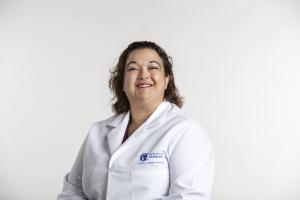
Description
SARS-CoV-2, the virus that causes COVID-19, changed the course of science for many researchers, including Claudia Kemper, Ph.D., the chief of the complement and inflammation research section at NHLBI.
Early in the pandemic Kemper and her colleagues confirmed a theory they held: that SARS-CoV-2 could activate complement, an ancient part of the immune system, in lung cells and sustain inflammation. This helped explain some cases of severe and prolonged COVID-19 illness. It also helped the researchers develop computational models for therapeutic targets.
“COVID-19 forced us to look into an important biological aspect of complement that we would have likely not explored under normal conditions,” Kemper explained.
Her lab studies other facets of complement, including the “complosome.” This is when complement can be activated inside of cells and may help explain inflammatory features of cardiovascular disease. The researchers are also studying physiological changes that can occur within cells, providing insight into other conditions, like cancer and autoimmune diseases.
“Complement, contrary to the prevailing opinion, still has many surprises for us in store,” said Kemper, who has researched the complement system for more than two decades and has not lost enthusiasm for it.
Her fascination with studying organisms started as a child. She grew up in a rural part of Germany. After school, she and her friends played outside. This instilled an early interest in animals, plants, and “how nature works,” she explained. Later as a student, she was drawn to biology. This included marine biology and learning about host-pathogen interactions.
For her Ph.D., she studied complement since it is the first line of defense against invading bloodborne pathogens. By focusing on complement’s function in barred sand bass, she learned more about the ancient immune system in fish and marine animals.
“This led me first to understand how very old the complement system is from an evolutionary point of view,” Kemper said. It then allowed her to develop the hypothesis, which is now widely accepted, that this ancient system is an orchestrator of single-cell physiology.
Her advice for future scientists is to embrace technology early on and follow personal interests in science. Resilience helps. For example, for every 10 experiments, about 1-2 works and generates meaningful insights. Therefore, having a peer- and mentor-supported network can be useful – especially for women and underrepresented minorities in the biological sciences.
As she leads the Laboratory for Complement and Inflammation Research, Kemper finds having a clearly communicated vision and common scientific goal for the researchers is essential to fostering teamwork. But she also strives to support exploratory and out-of-the-box thinking.
“I can truly say that the most transformative findings from my laboratory were made by postdocs who followed a gut feeling and performed some experiments that I either didn’t think of or that I thought may not lead to anything,” she noted.
She added, “These are the moments we live for as scientists – when true curiosity leads to a new and exciting team discovery.”



